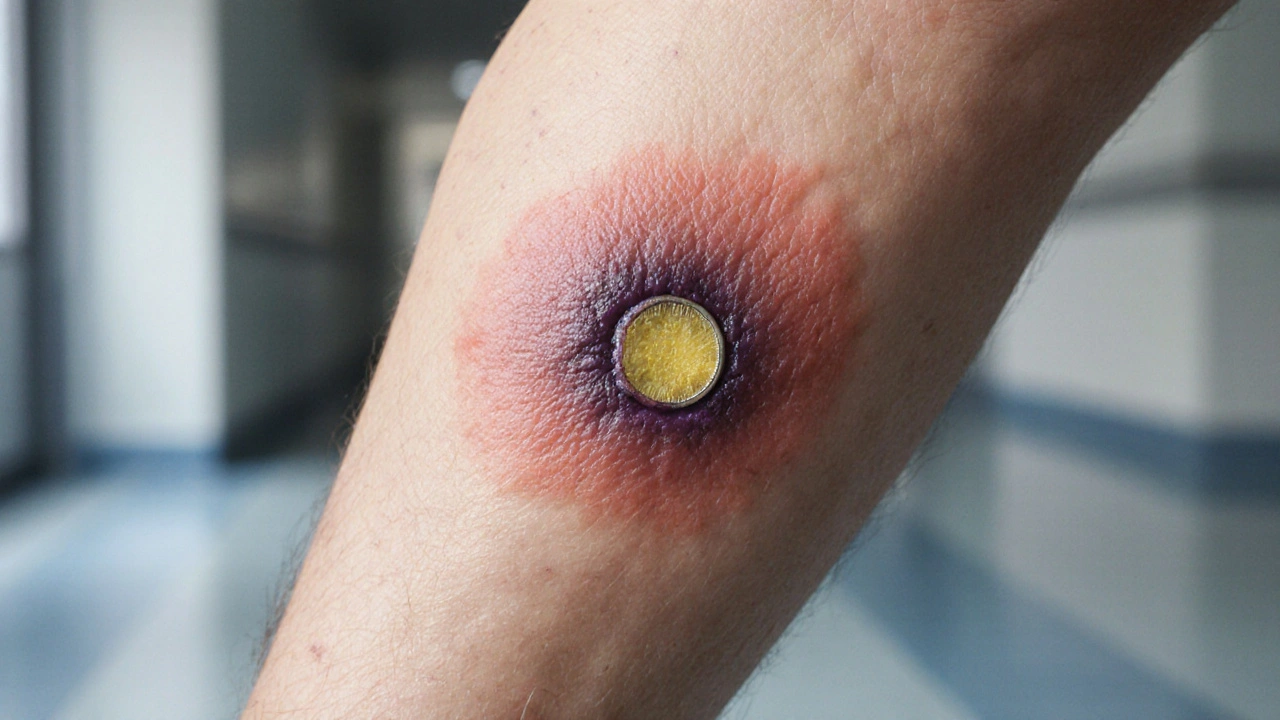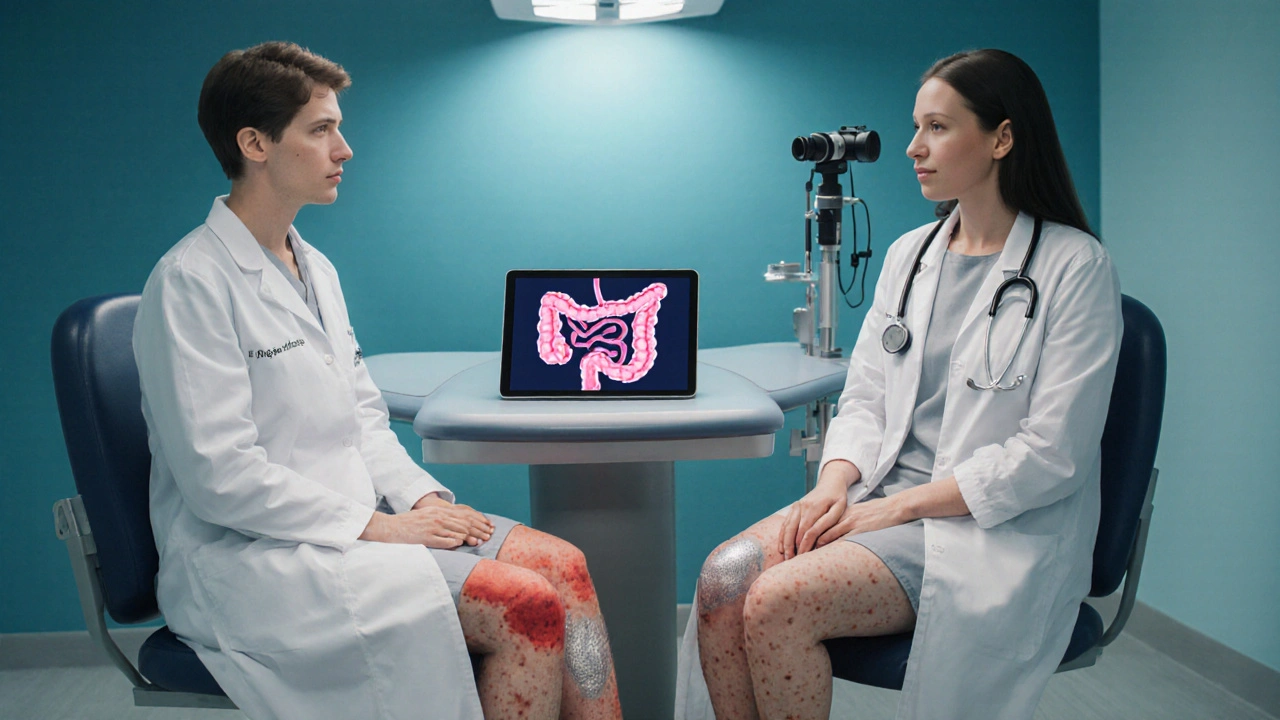Ever notice a rash that seems to flare up when your gut feels off? You’re not imagining it-there’s a real, medically backed link between colitis skin conditions. Understanding that connection can spare you weeks of mystery diagnoses and help you get the right treatment sooner.
What Exactly Is Colitis?
Colitis is a term for inflammation of the colon. The most common forms fall under the umbrella of Inflammatory Bowel Disease (IBD), which also includes Crohn's disease. While ulcerative colitis targets the lining of the large intestine, Crohn's can affect any part of the gastrointestinal tract, from mouth to anus.
Both conditions trigger an overactive immune response, releasing cytokines that don’t just stay in the gut. Those same inflammatory signals can surface on the skin, leading to a range of dermatologic problems.
Why Does the Gut Talk to the Skin?
The gut‑skin axis is a two‑way street. When the intestinal lining is inflamed, immune cells release substances like tumor necrosis factor‑alpha (TNF‑α) and interleukin‑6 (IL‑6). These molecules travel through the bloodstream, where they can irritate skin tissue, alter blood vessel function, and even change the behavior of skin‑resident immune cells.
Genetic factors also play a role. Certain HLA genes that predispose you to IBD also raise the risk of specific skin disorders. Think of it as a shared genetic blueprint that makes both the gut and skin vulnerable.
Skin Conditions Most Commonly Linked to Colitis
| Condition | Typical Appearance | Prevalence in IBD Patients | First‑Line Treatment |
|---|---|---|---|
| Pyoderma gangrenosum | Rapidly enlarging, painful ulcers with a purple edge | ~5% | Systemic steroids, biologics (e.g., infliximab) |
| Erythema nodosum | Firm, red‑brown nodules on shins | ~10% | NSAIDs, treat underlying IBD |
| Psoriasis | Silvery scales on elbows, knees, scalp | ~2% | Topical steroids, vitamin D analogues, biologics |
| Vitiligo | Patchy loss of skin pigment | ~1% | Topical tacrolimus, phototherapy |
| Lichen planus | Flat, purple, itchy papules | ~0.5% | Topical steroids, systemic agents if severe |

Spotting the Signs Early
Because these skin manifestations can mimic everyday conditions, it’s easy to dismiss them. Here’s a quick cheat‑sheet:
- Sudden ulcer on a leg or arm? Think pyoderma gangrenosum, especially if you also have abdominal pain.
- Red bumps on shins that don’t heal? Erythema nodosum often appears alongside a flare of colitis.
- Scaly patches that spread despite over‑the‑counter creams? Psoriasis may be the culprit, and controlling gut inflammation often eases the skin flare.
- White patches where skin used to be dark? Vitiligo can co‑occur, and early phototherapy works best.
- Itchy, purple bumps on wrists or ankles? Lichen planus is a tell‑tale sign of immune dysregulation.
If any of these sound familiar, bring a photo to your next gastroenterology or dermatology appointment. Visual evidence speeds up a correct diagnosis.
When to Call a Doctor
Not every rash needs urgent care, but some signs demand prompt attention:
- Rapidly expanding ulcers or lesions that bleed.
- Fever, chills, or severe pain with a skin sore.
- New skin problems that appear during a known IBD flare.
- Any skin change that interferes with daily life (e.g., constant itching, difficulty moving).
When you notice these, schedule a visit with both your gastroenterologist and a dermatologist. Coordinated care is the gold standard for IBD‑related skin issues.

Managing Both Gut and Skin Together
Treating the underlying colitis often improves skin symptoms. Here’s how clinicians typically approach it:
- Optimize IBD medication. Biologics like infliximab or adalimumab target TNF‑α, reducing both gut inflammation and skin lesions.
- Topical therapies. For localized psoriasis or eczema‑like rashes, steroids, calcineurin inhibitors, or vitamin D analogues work well.
- Systemic skin meds. Severe pyoderma gangrenosum may need high‑dose steroids, cyclosporine, or even newer JAK inhibitors.
- Lifestyle tweaks. A balanced diet low in processed sugars, regular gentle exercise, and stress‑reduction (yoga, meditation) can calm the immune system.
Never stop a prescribed IBD drug without a doctor’s guidance. Abrupt changes may trigger a flare, which in turn can worsen skin disease.
Coordinating Care: Gastroenterologist Meets Dermatologist
The best outcomes happen when the two specialists share notes. Ask your gastroenterology clinic if they have a dermatology liaison. If not, you can request a referral and provide the dermatologist with a copy of your recent colonoscopy report, lab values (CRP, ESR), and medication list.
Many hospitals now run joint IBD‑Dermatology clinics once a month. This setup lets you see both experts in a single visit, saving time and reducing miscommunication.
Frequently Asked Questions
Can I develop skin problems before my colitis is diagnosed?
Yes. Some patients notice erythema nodosum or psoriasis months before gastrointestinal symptoms appear. Those skin clues can actually prompt an earlier IBD work‑up.
Are over‑the‑counter creams enough for IBD‑related rashes?
They may offer temporary relief, but they rarely address the root immune trigger. If a rash persists for more than two weeks, see a dermatologist.
Do biologic drugs cure the skin side‑effects?
Biologics that block TNF‑α or IL‑12/23 often lead to dramatic improvement in both gut and skin lesions, though some patients still need adjunct topical treatment.
Is there a diet that helps both colitis and skin flare‑ups?
A low‑FODMAP or Mediterranean‑style diet reduces gut inflammation and can calm skin eruptions. Keep a food‑symptom diary to spot personal triggers.
Should I worry about skin cancer with IBD?
Long‑term immunosuppressants slightly raise the risk of skin cancer. Annual skin checks with a dermatologist are advisable, especially if you’re on thiopurines or biologics.
Understanding the gut‑skin connection empowers you to catch problems early, talk confidently with your doctors, and choose treatments that hit both targets. If you’ve noticed a new rash or a flare‑up of an old one, don’t wait-bring it up at your next appointment. The sooner you link the dots, the faster you’ll feel better.

Mark Evans
I totally get how frustrating it is when a skin flare seems to follow a gut upset. The gut‑skin axis explained in this post lines up with what many of us have experienced firsthand. Keeping your IBD meds consistent and letting your dermatologist know about any gut changes can really cut down on misdiagnoses. Also, a simple food diary might help you spot patterns before they become full‑blown rashes. Hang in there, and don’t be shy about sharing photos with your doctors – it speeds everything up.
Megan C.
If you’re not strictly following your prescribed regimen, you’re basically inviting those rashes onto your skin.
Greg McKinney
Honestly, I think the whole gut‑skin connection is overhyped; most rashes have simpler explanations.
Michelle Morrison
They don’t tell you that the pharma giants push biologics just to keep patients dependent, using the gut‑skin story as a marketing ploy.
harold dixon
Great breakdown! I’ve seen a few patients who didn’t connect the dots until we did a joint gastro‑derm visit. It’s fascinating how cytokines like IL‑6 can act as messengers between the colon and the epidermis, turning a tummy ache into a painful shin nodule. One tip that’s helped my folks is to track their stress levels alongside meals – the correlation is often clearer than you’d think. Also, remember that not every red bump is “just a bug bite”; context matters a lot.
Darrin Taylor
Look, the whole narrative about a “gut‑skin axis” is just a lab‑crafted story to sell more pricey supplements and biotech drugs.
Anthony MEMENTO
People tend to overlook the fact that systemic inflammation is the root cause of most extra‑intestinal manifestations, particularly in IBD patients. When you inhibit TNF‑α with agents like infliximab you’re essentially turning down the volume on the whole immune orchestra, which in turn calms both the colon and the skin. It’s not magic, it’s immunology at work. The literature backs this up with dozens of controlled trials showing parallel improvement in dermatologic scores. Also, diet isn’t just a side note; low‑FODMAP or Mediterranean regimes can reduce micro‑leakage in the gut, limiting antigenic load that would otherwise stimulate cutaneous immune cells. Lastly, regular dermatology check‑ups are essential, especially for those on long‑term immunosuppressants, to catch early skin cancers. All this goes to show that an interdisciplinary approach isn’t just nice‑to‑have, it’s necessary.
Jenny Spurllock
Interesting perspective.
Bart Cheever
This article reads like a patchwork of buzzwords without any solid guidance – the grammar is sloppy and the advice feels generic.
Maude Rosièere Laqueille
Actually, there are a few practical steps you can take right now: first, ask your gastroenterologist for recent CRP and ESR values and bring those to your dermatologist appointment; second, consider a low‑FODMAP diet trial for two weeks and note any changes in skin symptoms; third, schedule an annual full‑body skin exam if you’re on immunosuppressants, since the risk of non‑melanoma skin cancers is modestly increased. These actions help bridge the communication gap between specialties and give you concrete data to discuss.
Christopher Jimenez
The interplay between intestinal inflammation and cutaneous manifestations is a classic example of systemic immunopathology.
When you consider the cytokine cascade-TNF‑α, IL‑6, IL‑17-you realize that a localized gut flare can quickly become a whole‑body event.
Moreover, genetic predispositions such as HLA‑B27 create a scaffold upon which both ulcerative colitis and psoriasis can thrive.
Clinicians have long observed that patients on anti‑TNF agents often report dramatic improvements in their skin lesions as a secondary benefit.
This is not a coincidence; the biologic drugs are dampening the same inflammatory pathways that drive both organ systems.
Even diet plays a non‑trivial role, as certain food antigens can exacerbate intestinal permeability, allowing bacterial products to enter the circulation.
Those microbial components act as adjuvants, further stimulating the immune system in the dermis.
From a practical standpoint, a comprehensive work‑up should include CBC, CRP, ESR, and a skin biopsy when the diagnosis is ambiguous.
Imaging, such as MRI of the pelvis, can also reveal subclinical inflammation that correlates with skin findings.
Patients who neglect regular dermatological screening while on long‑term immunosuppressants risk developing squamous cell carcinoma at an elevated rate.
Therefore, dermatology referrals should be scheduled at least annually, even if the skin appears clear.
The psychosocial burden of visible rashes should not be dismissed, as it can worsen anxiety and perpetuate the gut‑brain‑skin loop.
Stress reduction techniques-mindfulness, yoga, CBT-have been shown to modestly lower inflammatory markers.
In my experience, interdisciplinary clinics that co‑locate gastroenterologists and dermatologists reduce diagnostic latency dramatically.
The cost savings from avoiding unnecessary antibiotic courses alone justify establishing such joint programs.
Ultimately, treating the gut and the skin as separate entities is a relic of outdated medicine; an integrated approach is the future.
Olivia Christensen
Thanks for the thorough rundown! 😊 It’s great to see how everything ties together, and I’ll definitely share this with anyone dealing with both gut and skin issues.